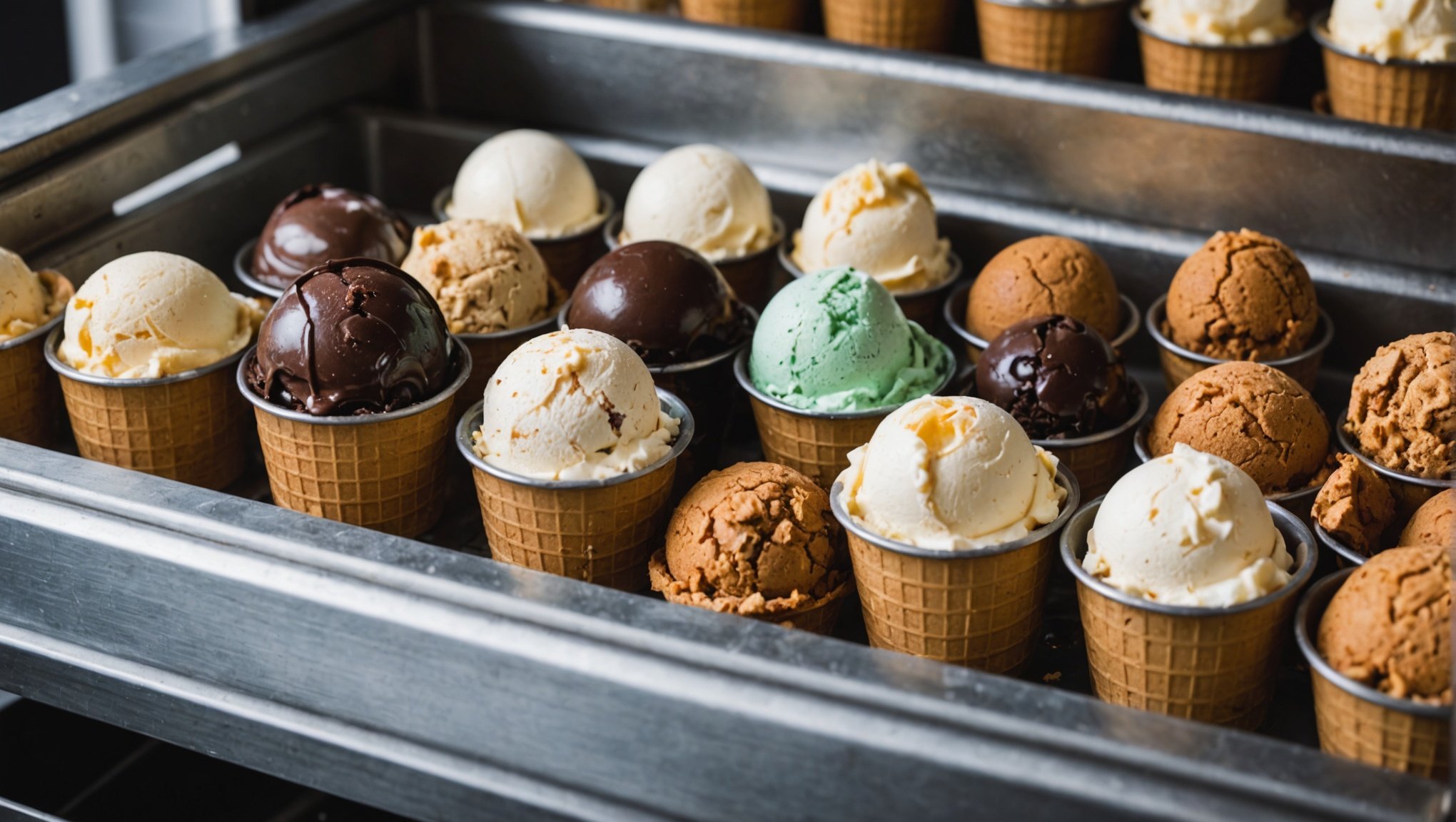The Ultimate Guide to Preserving Ice Cream Freshness: Pro Tips to Avoid Freezer Burn in Your Dessert Bar
Understanding the Basics of Freezer Storage
When it comes to preserving the freshness of your ice cream, understanding the basics of freezer storage is crucial. Freezers are designed to maintain extremely low temperatures, typically below freezing, to preserve the quality and safety of your frozen foods, including your beloved ice cream.
Temperature Control
The temperature of your freezer is the most critical factor in maintaining the freshness of your ice cream. Ideally, your freezer should be set at a temperature of -18°C (0°F) or lower. This ensures that the ice cream remains in a solid, frozen state, preventing the growth of bacteria and other microorganisms that can cause spoilage.
Additional reading : Top strategies for safely handling fresh produce in commercial kitchens
Storage Containers
Using the right storage containers can make a significant difference in preserving the freshness of your ice cream. Here are some tips for choosing the best containers:
- Freezer Safe Containers: Always use containers that are specifically designed for freezer storage. These containers are made from materials that can withstand the low temperatures without becoming brittle or leaking.
- Airtight Containers: Airtight containers are essential for preventing freezer burn. Freezer burn occurs when frozen foods are exposed to cold, dry air, causing the formation of ice crystals on the surface of the food. Airtight containers keep the air out, ensuring your ice cream stays smooth and creamy.
- Plastic vs. Glass: While both plastic and glass containers can be used, glass containers are often preferred because they do not absorb odors or flavors from other foods in the freezer. However, ensure that the glass containers are freezer-safe to avoid them shattering in the cold environment.
Organizing Your Freezer for Optimal Storage
Organizing your freezer is not just about throwing your ice cream in and hoping for the best. Here’s how you can optimize your freezer storage to keep your ice cream fresh for a longer period.
Also to see : Top inventory management techniques for streamlining operations in high-volume restaurants
Cooling Zones
Just like your fridge, your freezer has different cooling zones that are more or less suitable for different types of foods. Here’s a breakdown of how you can use these zones effectively:
| Storage Location | Temperature | Best For |
|---|---|---|
| Top Shelf | Consistently cold | Ice cream, frozen desserts |
| Middle Shelves | Slightly warmer | Frozen meats, vegetables |
| Bottom Shelf | Coldest | Long-term storage of frozen foods |
- Top Shelf: This is the best place to store your ice cream and other frozen desserts. The consistent cold temperature here helps in maintaining the texture and flavor of your ice cream.
- Middle Shelves: These shelves are slightly warmer and are ideal for storing frozen meats and vegetables.
- Bottom Shelf: This is the coldest part of your freezer and is best for long-term storage of frozen foods.
Labeling and Rotation
To ensure that your ice cream does not get lost in the freezer and to maintain its freshness, it’s important to label and rotate your containers regularly.
- Labeling: Use a marker to label each container with the date it was stored and what it contains. This helps you keep track of how long the ice cream has been in the freezer.
- Rotation: Rotate your containers every few weeks to ensure that older items are used before they expire. This practice also helps in maintaining even cooling throughout the freezer.
Tips for Freezing Ice Cream
Freezing ice cream is not as simple as just putting it in the freezer. Here are some tips to ensure your ice cream freezes perfectly and remains fresh.
Freezing Techniques
- Flash Freezing: Flash freezing involves freezing the ice cream as quickly as possible to prevent the formation of large ice crystals. This can be achieved by placing the ice cream in a shallow metal pan and then transferring it to an airtight container once it is frozen solid.
- Portion Control: Freezing ice cream in smaller portions can help in maintaining its freshness. Smaller portions freeze faster and are easier to thaw when you need them.
Avoiding Freezer Burn
Freezer burn is one of the most common issues when it comes to storing ice cream. Here are some tips to avoid it:
- Cover the Ice Cream: Always cover your ice cream with plastic wrap or aluminum foil before placing it in an airtight container. This extra layer of protection prevents freezer burn.
- Use Freezer Bags: If you are using freezer bags, make sure to remove as much air as possible before sealing. This prevents the formation of ice crystals on the surface of the ice cream.
Long-Term Storage of Ice Cream
If you plan to store your ice cream for an extended period, here are some tips to ensure it remains fresh.
Temperature Stability
Temperature stability is key when it comes to long-term storage of ice cream. Ensure that your freezer maintains a consistent temperature below -18°C (0°F). Any fluctuations in temperature can cause the ice cream to degrade faster.
Storage Containers for Long-Term Use
For long-term storage, it’s best to use containers that are specifically designed for this purpose. Here are some features to look for:
- Insulated Containers: Insulated containers help in maintaining the temperature inside the container, even if there are fluctuations in the freezer temperature.
- Freezer-Safe Materials: Ensure that the containers are made from materials that are safe for long-term freezer storage. These materials should be durable and able to withstand the cold temperatures without degrading.
Energy Efficiency and Food Safety
When it comes to preserving ice cream, energy efficiency and food safety are also important considerations.
Energy Efficiency
Using energy-efficient freezers can help in reducing your energy bills while also ensuring that your ice cream is stored at the optimal temperature. Here are some tips for choosing an energy-efficient freezer:
- Look for Energy Ratings: Check the energy rating of the freezer before purchasing. Freezers with higher energy ratings are more efficient.
- Proper Maintenance: Regularly clean and maintain your freezer to ensure it operates efficiently. Defrosting the freezer periodically can also help in maintaining its performance.
Food Safety
Food safety is paramount when storing ice cream. Here are some tips to ensure your ice cream remains safe to eat:
- Check Expiration Dates: Always check the expiration dates of your ice cream before storing it. Expired ice cream can be unsafe to eat.
- Store at Safe Temperatures: Ensure that your freezer is set at a safe temperature below -18°C (0°F). This prevents the growth of bacteria and other microorganisms.
- Use Clean Containers: Always use clean containers to store your ice cream. Dirty containers can contaminate the ice cream, making it unsafe to eat.
Practical Insights and Actionable Advice
Here are some practical insights and actionable advice to help you preserve the freshness of your ice cream:
Freezing Fruits and Vegetables
If you plan to use fruits and vegetables in your ice cream, freezing them properly can help in maintaining their freshness.
- Blanching: Blanching fruits and vegetables in boiling water before freezing can help in preserving their color and texture.
- Flash Freezing: Flash freezing these ingredients can prevent the formation of large ice crystals, which can affect the texture of your ice cream.
Using Vacuum-Sealed Containers
Vacuum-sealed containers can be very effective in preserving the freshness of your ice cream.
- Removing Air: Vacuum-sealing removes air from the container, preventing freezer burn and spoilage.
- Long-Term Storage: Vacuum-sealed containers are ideal for long-term storage as they prevent moisture and air from entering the container.
Preserving the freshness of your ice cream is a combination of using the right storage containers, maintaining the optimal temperature, and following proper freezing techniques. Here is a summary of the key points to keep in mind:
Key Points for Preserving Ice Cream Freshness
- Temperature Control: Maintain a consistent temperature below -18°C (0°F) in your freezer.
- Storage Containers: Use airtight, freezer-safe containers to prevent freezer burn.
- Labeling and Rotation: Label and rotate your containers regularly to ensure older items are used before they expire.
- Freezing Techniques: Use flash freezing and portion control to freeze your ice cream efficiently.
- Energy Efficiency: Choose energy-efficient freezers and maintain them properly.
- Food Safety: Store your ice cream at safe temperatures and use clean containers.
By following these tips, you can enjoy your ice cream for a longer period while maintaining its freshness and quality.
Detailed Table: Comparing Storage Methods
Here is a detailed table comparing different storage methods for ice cream:
| Storage Method | Temperature | Shelf Life | Advantages | Disadvantages |
|---|---|---|---|---|
| Airtight Containers | Below -18°C (0°F) | Up to 3 months | Prevents freezer burn, easy to use | Can be expensive |
| Vacuum-Sealed Containers | Below -18°C (0°F) | Up to 6 months | Removes air, prevents spoilage | Requires special equipment |
| Freezer Bags | Below -18°C (0°F) | Up to 2 months | Affordable, easy to use | May not be as effective as airtight containers |
| Insulated Containers | Below -18°C (0°F) | Up to 6 months | Maintains temperature, durable | Can be bulky |
Quotes and Anecdotes
- “The key to preserving ice cream freshness is maintaining the right temperature and using the right storage containers. It’s all about creating an environment that prevents freezer burn and spoilage,” says a home food preservation expert.
- “I once stored my ice cream in a regular plastic container and ended up with a batch that was full of ice crystals. Now, I always use airtight containers and vacuum-seal them for the best results,” shares a home cook.
By following these pro tips and using the right storage methods, you can enjoy your ice cream for a longer period while maintaining its freshness and quality. Happy freezing












